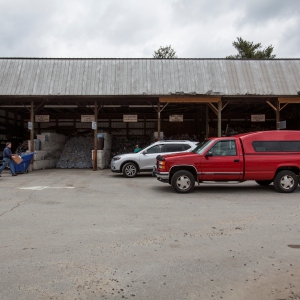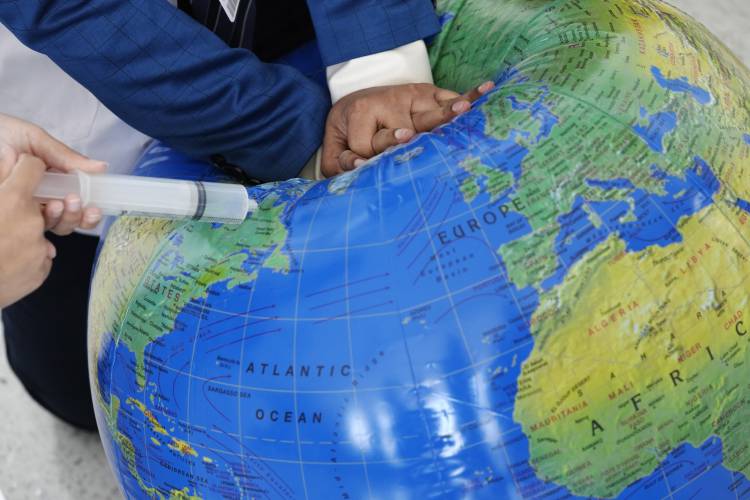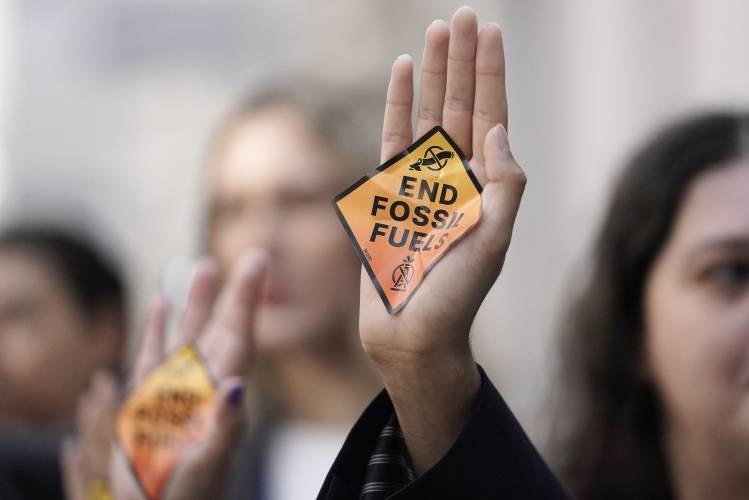Opinion: How to account for the human cost of climate change
| Published: 12-05-2023 6:00 AM |
Dan Weeks and Dr. Sindiso Mnisi Weeks live in Nashua.
Our children have a rambunctious streak. When their seemingly endless energy exceeds their not-so-endless judgment, things tend to break or get damaged.
As parents, our job is to help them understand that actions have consequences. When one of them damages the family ukulele or kicks a soccer ball through the window, they must do two things. First, apologize to the person or people they have harmed, however unintentionally (words matter). Second, repair the damage done to the best of their ability (words alone do not suffice).
What about when rambunctious nations with a seemingly endless thirst for energy lack judgment in how they consume it and damage other nations as a result?
One of us is from the richest and most energy-intensive country on earth. Since the dawn of the Industrial Revolution, the United States has achieved a high standard of living for many Americans by burning copious amounts of coal, oil, and gas. Dan’s family, with its history of industrial manufacturing, has benefited greatly from the availability of cheap and abundant power.
But “cheap” can sometimes prove to be expensive. By failing to account for the human and environmental costs of burning fossil fuels, our nation has been slow to consider cleaner and less costly alternatives until now. Our fossil fuel spree has resulted in over 509 gigatons of heat-trapping carbon dioxide (CO2) released into the atmosphere, which is heating our planet at a rate not seen since the dawn of human civilization.
(In case “gigaton” isn’t part of your daily lexicon, you might be interested to know that one gigaton (one billion metric tons) is equivalent to 10,000 fully loaded aircraft carriers. That’s a lot of weight for an invisible gas and it makes for a potent and long-lasting atmospheric blanket, along with other greenhouse gases like methane and nitrous oxide.)
All told, the U.S. is responsible for more than 20 percent of cumulative carbon pollution worldwide. More than half of those CO2 emissions have occurred since the 1970s when oil companies knew that burning fossil fuels would cause global warming and began their decades-long disinformation campaign. Talk about bad judgment — for the planet, if not their profits.
Article continues after...
Yesterday's Most Read Articles
 Neighboring landowner objection stalls Steeplegate redevelopment approval
Neighboring landowner objection stalls Steeplegate redevelopment approval
 Northeast Coffee Festival comes to Concord this weekend
Northeast Coffee Festival comes to Concord this weekend
 Hopkinton tries to nab out-of-town trash bandits
Hopkinton tries to nab out-of-town trash bandits
 On the Trail: Democrat Maggie Goodlander jumps into race to succeed Kuster
On the Trail: Democrat Maggie Goodlander jumps into race to succeed Kuster
 NH Senate panel frowns on bill to ease vehicle inspection requirements
NH Senate panel frowns on bill to ease vehicle inspection requirements
 Steeplegate project to reopen to public comment as developer seeks to reduce required parking
Steeplegate project to reopen to public comment as developer seeks to reduce required parking
The other of us is originally from the poorest and least energy-intensive continent on earth. Over the same period, Africa’s now 56 nations spanning an area three times larger than the United States, with a population four times greater today, have emitted some 43 gigatons of CO2. That’s less than 2 percent of the global total of around 2,500 gigatons since 1850. Meanwhile, a sizable portion of the fossil fuels and other natural resources extracted from African soils, not to mention nearly 13 million African souls, were taken by American and European powers to hasten their own development.
In a cruel irony that hits close to home for Sindiso, the African nation with the highest CO2 emissions, South Africa, achieved its dubious distinction after the apartheid government started burning gigatons of coal to support “whites-only” development in the mid-20th century. One of those coal-fired power plants was erected in the middle of Soweto, the nation’s largest “blacks-only” township, where Sindiso grew up and many of her family members reside.
Although the power mainly flowed to the nearby city of Johannesburg and its wealthy “white” suburbs, the soot stayed put. It is a likely contributor to the asthma and other respiratory conditions with which she and other relatives must live, and from which many have died, along with more than 8 million people worldwide who die each year from fossil fuel air pollution.
The price of climate damage caused by burning coal, oil, and gas extends far beyond Soweto and its soot. Across the African continent, rising temperatures and resulting “evaporative demand” are leading to widespread drought and desertification that threaten already fragile food and water supplies for hundreds of millions of people. These effects, combined with extreme heat, storms, and floods brought on by global warming, are wreaking havoc on local communities and economies.
In the Greater Horn of Africa, for example, an unrelenting drought has brought acute food insecurity to countless people across seven countries after a record five consecutive failed rainy seasons. The drought would not have been possible without human-induced climate change, according to local and international scientists with the World Weather Attribution initiative, whose research found “the combination of low rainfall and high evapotranspiration … would not have led to drought at all in a 1.2°C cooler world.” Tough break for one of the world’s most impoverished regions with negligible CO2 emissions.
In fact, the latest data from the World Health Organization for November 2023 show 47 million people are still facing crisis-level food insecurity in the region, including 12 million acutely malnourished children, and 19 million people are currently displaced as a result of famine and associated violent conflict. Not to mention the outbreaks of malaria, cholera, dengue and other diseases that have reached their highest ever level this century.
Reading these drought reports out of East Africa calls to mind uncomfortable memories of Cape Town’s “day zero,” when South Africa’s second-largest city of four million people was on the brink of running dry during our last full visit in 2018. After three consecutive years of extreme drought, made at least 200 percent more likely by climate change, the city’s 14 dams and pipelines could not keep up. The drought did more than put an end to our regular showers and our kids’ hopes of swimming in a pool; it subjected millions of already impoverished South Africans to extreme rationing and caused widespread unemployment in the agricultural, tourism, and related sectors.
These are but two examples of the price being paid across Africa and large swaths of the Global South, and increasingly here at home, due to our stubborn addiction to fossil fuels. Although economic measures cannot possibly capture the human toll, careful accounting by The Economist finds that increased droughts, flooding, and crop failures due to climate damage could impose a $7.9 trillion tax on global economic growth by 2050. Every economy suffers, but none more than Africa’s, where the loss in GDP is expected to top 4.7 percent, four times the projected losses in North America and nearly three times those of Europe. The resulting hunger, joblessness, and civil strife could force over a billion people to leave their homes by mid-century in search of basic human needs.
Against this backdrop, the demands of poor and developing nations to finally capitalize a ”loss and Damage” fund at COP 28, the annual UN climate conference now underway in Dubai, could not be more pressing. It is not enough to establish the fund that was first proposed over 30 years ago. Those nations who are most responsible for climate change – including the U.S. and China, now the world’s largest emitter – must make meaningful, binding commitments to repair the damage done by investing in the global clean energy transition and climate adaptation. As American citizens, we can help make it so by urging the Biden administration to step up today with a capital commitment that matches our means and an agreement to phase out fossil fuels.
As the fund enables developing countries to deploy cheaper, cleaner wind and solar power, along with badly-needed infrastructure to withstand climate damage, all nations stand to benefit from reduced carbon emissions, increased geopolitical stability, and a higher quality of life. Sounds like a bargain sensible enough for even our rambunctious kids to get on board!




 Opinion: An opportunity to help law enforcement protect children
Opinion: An opportunity to help law enforcement protect children Opinion: Invest in child care for NH families
Opinion: Invest in child care for NH families Opinion: The slippery slope that should scare us? The trend of legislatures getting involved in personal medical decisions.
Opinion: The slippery slope that should scare us? The trend of legislatures getting involved in personal medical decisions. Opinion: Protecting NH from PFAS
Opinion: Protecting NH from PFAS
